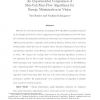1110 search results - page 17 / 222 » Neurocomputing for vision research |
EMMCVPR
2001
Springer
14 years 4 days ago
2001
Springer
After [15, 31, 19, 8, 25, 5] minimum cut/maximum flow algorithms on graphs emerged as an increasingly useful tool for exact or approximate energy minimization in low-level vision...
PCM
2001
Springer
14 years 2 days ago
2001
Springer
Abstract. In this paper, we discuss the development of wearable systems which we collectively term VizWear. Vision plays an important role in both people's and computers'...
DAGM
1999
Springer
13 years 12 months ago
1999
Springer
We believe intelligence does not dwell solely in brain but emerges from active interactions with environments through perception, action, and communication. This paper give an over...
CVPR
2007
IEEE
14 years 9 months ago
2007
IEEE
Markov Random Field (MRF) models are a popular tool for vision and image processing. Gaussian MRF models are particularly convenient to work with because they can be implemented u...
IJCV
1998
13 years 7 months ago
1998
There are many computational vision techniques that fundamentally rely upon assumptions about the nature of diffuse reflection from object surfaces consisting of commonly occurrin...

